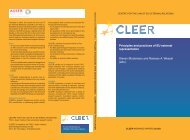Institutional Factors Affecting Agricultural Land Markets
Institutional Factors Affecting Agricultural Land Markets
Institutional Factors Affecting Agricultural Land Markets
You also want an ePaper? Increase the reach of your titles
YUMPU automatically turns print PDFs into web optimized ePapers that Google loves.
14 | CIAIAN, KANCS, SWINNEN, VAN HERCK & VRANKEN<br />
only deals with claims under €1,860. Since one does not need to have a legal adviser, the cost<br />
is limited to an administrative fee of €35.<br />
In this regard, EU accession has also had a major effect on rental markets in the Central and<br />
Eastern European accession countries. The combination of improved security of tenancy and<br />
ownership rights and improved legal frameworks for transactions has resulted in an inflow of<br />
foreign capital into the land markets directly or indirectly through agri-food industry<br />
investment.<br />
8. Alternative land use<br />
Usually, land can be used not only for agriculture but also for other sectors of the economy. If<br />
there is such an opportunity, land values will reflect this potential, alternative land use. In a<br />
competitive market, land values reflect returns from the most profitable use of land. If the<br />
most profitable use of land is non-agricultural, e.g. urban housing, then land values will be<br />
determined by the profitability of urban housing. If, however, the non-agricultural use of land<br />
is expected to be profitable in the future, then the current land price will reflect the sum of<br />
the discounted stream of rents from agriculture up to the time of conversion plus the<br />
discounted stream of expected rents from non-agricultural use from that time onwards<br />
(Plantinga et al., 2002).<br />
There is evidence of speculation based on changes in land use, and for example in Greece,<br />
Spain and Bulgaria, plots close to coastal areas are more expensive than plots in more remote<br />
areas, since they are often used for non-agricultural purposes (e.g. for tourism or residential<br />
development). Also in Ireland, experts believe that non-agricultural use (residential and<br />
public infrastructure) was a main driver behind the price increase of agricultural land in the<br />
1990s. In the Netherlands, a highly urbanised country with an extremely dense population,<br />
land prices are influenced by the implicit ‘call option’ that is embedded in the land price. This<br />
call option is the chance to develop agricultural land outside agriculture and depends on the<br />
probability that this transformation becomes possible. <strong>Land</strong> close to urban areas should carry<br />
a higher premium than peripheral land. Dutch zoning regulation classifies land into sectors<br />
with regard to future land use, ranging from land ready for development (red label) to regular<br />
agricultural land without development prospects (green label). The option value follows<br />
along the lines of this classification.<br />
Speculation about changes in land use is also reflected by the fact that in general, the price of<br />
smaller plots is substantially higher than for larger plots. For example in Slovakia, the<br />
average price of a parcel smaller than 1 ha was more than 60,000 SKK/ha in 2005, while the<br />
price of a parcel between 1 and 5 ha fluctuated between 40,000 SKK/ha and 20,000 SKK/ha.<br />
The largest parcels (of 5 ha or more) were by far the cheapest, as the average price was<br />
10,000 SKK/ha or less (Figure 2).








